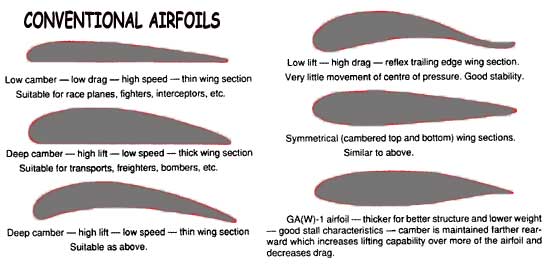

įigure 1: percentage of Wing profile drag on total aircraft drag for various aircraft type This is because of the increase in relative wing area. As the size of the aircraft decreases, the contribution of the wing profile drag on the total aircraft drag increases. Third of the total drag for transport aircraft. For most aircraft, the total aircraft drag at cruise condition is mainly occurred by the wing profile drag. This force has two components, one which is perpendicular to the direction of motion called lift and another which is parallel to the direction of motion is called drag. The wing profiles for most aircraft are of airfoil-shaped, and when this airfoil- shaped wing moves through a fluid, it produces an aerodynamic force. Accordingly, the emphasis in the research program shifted toward natural laminar-flow (NLF) airfoils in an attempt to obtain lower cruise drag coefficients while retaining the high maximum lift coefficients.
#Low camber airfoil series
The initial emphasis in this research program was on the design and testing of turbulent-flow airfoils with the basic objective of producing a series of airfoils which could achieve higher maximum lift coefficients than the airfoils used on general aviation airplanes during that time. The research on advanced-technology airfoils for general aviation applications started way back in 1900s. KeywordsDesign optimization of the wing profile figure of merit lift coefficient profile drag coefficient laminar flow NACA 2412 NACA 3412 The simulation results are comparable to the virtual wind tunnel results. The results obtained from the study shows that by increasing the camber of NACA airfoil, the CL/CD ratio can be increased also the pressure and velocity contours becomes much smoother with NACA 3412 as compared with NACA 2412 airfoils. For this purpose, NACA 2412 Airfoil which has a maximum camber of 2% located at 40% (0.4 Chords) from the leading edge with a maximum thickness of 12% of the chord & NACA 3412 which has a maximum camber of 3% located at 40% (0.4 Chords) from the leading edge with a maximum thickness of 12% of the chord are employed. Here we are going to analyse the impact of increase in the percentage of camber on the ratio of CL/CD.

The amount of laminar flow can be maximised on a straight wing by using very carefully tailored shapes to move the maximum thickness very far aft on the wing. We focused our research on a straight wing. Here in this paper, we are trying to increase the CL/CD ratio by increasing the percentage of the camber in the NACA airfoil. FOM is the ratio of the section maximum lift coefficient (CL, max) to the cruise section profile drag coefficient (CD). In order to minimize the wing profile drag the figure of merit (FOM) applicable to aircraft should be maximized. The wing profile for most aircraft is of airfoil- shaped. Designers main focus is on the design optimisation of the wing profile so as to reduce the drag and thus obtaining better fuel efficiency and overall performance of the aircraft. Comparison of Aerodynamic Performance of Aircraft Wing by Changing the Maximum Camber As Percentage of the ChordĪbstract In transport aircraft, the wing contributes about 1/3rd of the total aircraft drag.


 0 kommentar(er)
0 kommentar(er)
